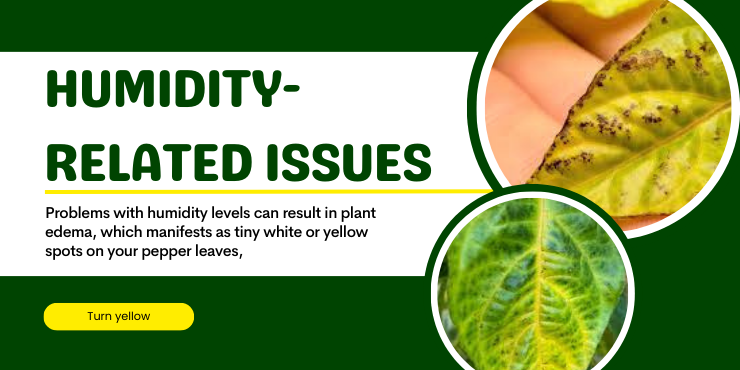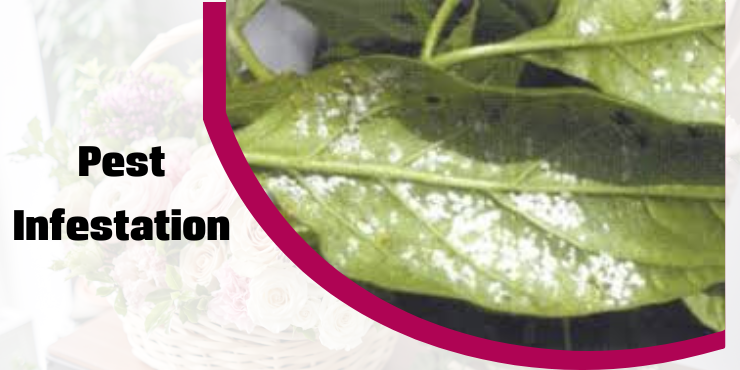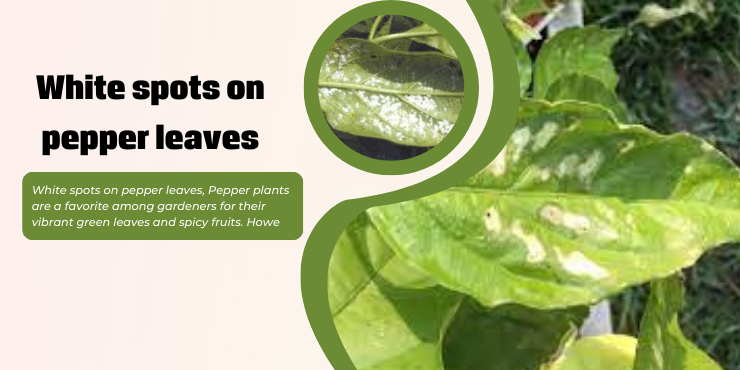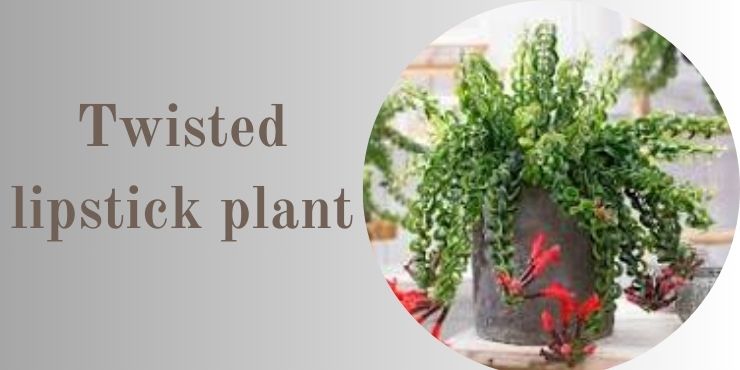Introduction
White spots on pepper leaves, Pepper plants are a favorite among gardeners for their vibrant green leaves and spicy fruits. However, the appearance of white spots on pepper leaves can be concerning. In this article, we will delve into the reasons behind these white spots, how to prevent them, and effective treatments to restore your pepper plants to their former glory.
Understanding the Symptoms
Before we explore the causes of white spots on pepper leaves, it’s essential to recognize the symptoms. White spots typically manifest as powdery or fuzzy patches on the upper or lower surface of the leaves. These spots may start small but can quickly spread, covering larger areas if left untreated.
Why Do White Spots on Pepper Leaves?
White spots can develop on your pepper leaves due to various factors, including insect infestations, bacterial infections, and pest attacks. Inappropriate light and humidity conditions can also contribute to the formation of these white spots. Furthermore, over- or under-feeding your pepper plants can lead to the appearance of white spots.
- The Role of Powdery Mildew and Other Fungal Infections
- Powdery mildew is a prevalent cause of white spots on pepper leaves.
- This fungal issue is characterized by small white spots or mold, which become apparent upon close examination of the leaves.
- Powdery mildew tends to affect plants that are not growing in their optimal conditions.
In addition to powdery mildew, your pepper plants may be susceptible to phytophthora blight, another fungal infection that can result in pale or white spots. It’s important to note that peppers can easily transmit fungi from one plant to another, so it’s advisable to check neighboring plants in your garden for signs of infection.”
Nutrient Insufficiency
The presence of white spots on your pepper leaves may indicate a lack of essential nutrients. Calcium deficiency is a common cause, while pale and sizable spots could be attributed to deficiencies in nitrogen, iron, manganese, or magnesium. Nutrients play a vital role in all aspects of plant growth, so if your pepper plants appear unhealthy, it’s essential to assess their nutrient intake.
When was the last time you provided your peppers with a well-balanced fertilizer suitable for their specific growth stage? Have you enriched their soil with organic nutrients? Considering the nutritional requirements of your pepper plants can help determine whether nutrient insufficiency is responsible for the appearance of white spots or not.
Light-Related Issues
White spots on pepper leaves can often be attributed to light-related problems. When pepper plants receive either too little or too much light, it can result in the development of yellow spots on the leaves.
Insufficient light can cause the spots to appear initially, eventually leading to the entire leaf becoming pale. Additionally, you may observe that the pepper plants become elongated and weak under low-light conditions.
Conversely, excessive exposure to sunlight, especially during the summer, can also lead to the formation of spots, followed by the browning and curling of leaves. These sunscald spots typically manifest around the edges of your pepper leaves. Furthermore, excessive sunlight can cause the pepper substrate to dry out rapidly, affecting the overall health of the plants.
Humidity-Related Issues

Problems with humidity levels can result in plant edema, which manifests as tiny white or yellow spots on your pepper leaves, particularly around the tips and edges.
This phenomenon occurs when transpiration is hindered due to excessively high atmospheric humidity, leading to the trapping of water within your pepper plants. It’s important to note that this condition can pave the way for secondary diseases to take hold.
Many gardeners often overlook the significance of humidity when cultivating peppers and other plants, primarily because humidity is not visible and may not seem crucial. However, it is indeed a critical factor and could be the underlying cause of the white spots on your pepper leaves.
Excessive Organic Fertilization
While nutrient deficiency can result in pale spots on your White spots on pepper leaves, the opposite scenario of excessive nutrients can also pose problems. When your pepper plants receive an abundance of inorganic nutrients, they may exhibit paleness, and their leaves may suffer from burns.
However, when it comes to organic nutrients, an overabundance can lead to pepper plant burn and may even attract fungal invaders such as powdery mildew.
It’s essential to understand that many fungi species play a role in breaking down organic matter. Consequently, an excessive presence of fresh organic nutrients in the soil can lead to the proliferation of fungi, covering both the soil and various parts of your pepper plants.
This underscores the importance of ensuring that any animal manure used as fertilizer is fully decomposed before application.
Pest Infestation

Pepper plants are susceptible to attacks by pests like spider mites, aphids, and thrips. These pests feed on the juices of your pepper plants, causing them to appear pale and weak.
Most of these pests don’t leave visible bite marks on your pepper leaves, which can sometimes lead to confusion, making it seem like the plants are under microbial attack. However, a closer look at the pepper leaves or examination of their petioles may reveal the presence of White spots on pepper leaves, indicative of invertebrate pest activity.
For instance, weevils deposit their white eggs on pepper leaves, while spider mites cloak themselves in web-like silk with a white appearance. As evident, these pests may indeed be the root cause of the white spots you observe on your pepper plants.
Bacterial and Viral Infections
Bacterial assaults on pepper plants, such as bacterial leaf spots, are quite common, particularly among peppers growing in nutrient-deficient soil.
Initially, you may notice the appearance of white, pale, yellow, or brown spots on a pepper leaf, and these spots can rapidly spread to other leaves. If you identify a bacterial spot, it’s crucial to inspect other plants in your garden and attempt to locate the source of the infection.
Viral attacks, such as the mosaic virus, can also manifest as white, pale, brown, or black spots on bell pepper leaves. The small brown spots on pepper leaves often feature a white or pale flaky center as the plants try to isolate and dry up the infected leaf portions in an attempt to contain the virus.
Consider the Possibility of External
Factors Have you ever considered whether the white spots on your pepper leaves might be the result of dirt, paint, or dust? It’s plausible that someone accidentally splashed paint or another white substance onto the leaves, leaving persistent spots. Take a moment to assess whether paint is readily accessible in your vicinity or if children have access to white paint. If this is the case, don’t dismiss this possibility.
If the small White spots on pepper leaves on your peppers are merely dust, they should be relatively easy to wipe away. However, if they are indeed painted, it’s essential to ensure that the plants remain healthy, as paint may potentially be toxic to peppers.
Remedying White Spots on Your Pepper Leaves
To address the issue of white spots on your pepper leaves, several steps can be taken, including the use of fungicides, proper nutrition, treatment of bacterial and fungal infections, and the application of remedies like baking soda or neem oil. In more severe cases, it may be necessary to consider disposing of the afflicted pepper plants.
Isolation and Pruning of Affected Pepper Plants
Upon observing white spots on your pepper leaves, it is advisable to take immediate action by either isolating the affected plant, pruning it, or implementing both measures.
If it’s feasible, relocating the plant to a different growing spot can be beneficial, as it allows for thorough examination while keeping it separated from other plants. However, if you choose to prune the affected areas, there is no absolute guarantee that the white spots won’t reappear unless the plant is treated.
The purpose of inspecting the plant before pruning is to pinpoint the exact cause of the white spots, facilitating the identification of an appropriate solution.
Utilizing Fungicides Effectively
Curious about how to effectively combat fungus on your pepper plants? Look no further. Simply visit a nearby gardening store and acquire plant-safe fungicides tailored for your peppers.
Fungicides are primarily chemical products designed to either eliminate fungi or impede their growth in crops. It’s crucial to select the appropriate fungicide that targets the specific fungal issue affecting your peppers.
However, exercise caution and avoid excessive use of fungicides, as they can become toxic in large quantities. Follow the provided instructions diligently and ensure you observe progress in inhibiting the white spots before continuing the product’s application.
Ensuring Proper Nutrition for Your Pepper Plants
What happens when you provide your plants with proper nutrition? They receive the complete spectrum of essential nutrients required for optimal health, resulting in vibrant, green leaves and the production of beautiful flowers and healthy fruits in your pepper plants. The key is to ensure your peppers receive the correct type of fertilizer.
Additionally, it’s vital to confirm that the substrate is rich in nutrients, especially organic ones that do not leach away quickly. Keep in mind that plants of varying ages have distinct fertilizer requirements; for instance, vegetative peppers benefit from fertilizer with a high nitrogen content.
Optimal Plant Placement
When cultivating pepper plants, it’s crucial to select the right location, taking into account their temperature, humidity, and lighting requirements. Ideally, maintain a temperature range of 70-80 degrees Fahrenheit and a humidity level of around 70 percent. Additionally, ensure your peppers receive a minimum of six hours of direct sunlight each day.
By growing your pepper plants in these optimal conditions and applying the tips provided in this article, you can rest assured about the health and vitality of your plants.
Harnessing the Power of Baking Soda and Neem Oil
Two organic allies for the well-being of your plants are baking soda and neem oil. Baking soda is a potent tool for repelling fungi and other harmful microorganisms that may afflict your peppers. Despite its unassuming appearance, baking soda has the potential to transform peppers with white spots into vibrant green specimens. To utilize it effectively, simply mix the powder with water and regularly apply the solution to your pepper leaves. You may also consider applying some of the solution to the soil, but exercise moderation in its usage.
Neem oil, on the other hand, proves invaluable in repelling larger pests like insects, spiders, and other invertebrates. For optimal results, spray the oil during the early morning or evening to deter these unwelcome visitors. It’s essential to avoid excessive use of neem oil to prevent any potential damage or deterioration of your pepper leaves.
Addressing Bacterial and Fungal Issues
Effectively treating bacterial leaf spots and other ailments like the mosaic virus in your pepper plants often involves the use of commercially available chemical products designed to eradicate the bacteria and viruses affecting your plants.
These chemical treatments are generally reliable, provided you select the appropriate product tailored to the specific infection afflicting your plants.
However, it’s essential to also focus on bolstering the overall health of your plants, reducing their reliance on medication for recovery. One way to do this is by providing your plants with a fertilizer rich in potassium and phosphorus, as these nutrients enhance their natural disease-fighting capabilities. Ensure that your plants are adequately nourished and not deficient in essential nutrients.
Responsible Disposal of Afflicted Pepper Plants
Upon discovering white spots on the leaves of your common pepper plants, it’s advisable to isolate and attempt treatment. However, if the spots persist and continue spreading from leaf to leaf, you may have no choice but to dispose of the affected plants to prevent the disease from spreading to healthy ones.
When disposing of the pepper plant, place it at a considerable distance from your garden or discard it in your waste bin. This precaution helps mitigate the risk of the disease, if present, spreading to your healthy plants. Remember that it’s best to exhaust all efforts to address the problem before resorting to the disposal of sick plants.
Conclusion
White spots on pepper leaves may be unsightly, but they can be managed effectively with the right knowledge and preventative measures. By identifying the causes, taking proactive steps, and using appropriate treatments, you can ensure your pepper plants remain healthy and productive.
FAQs
Are white spots on pepper leaves harmful to humans?
No, white spots on pepper leaves are not harmful to humans. They are typically a sign of plant stress or infestation.
Can I use chemical pesticides to treat white spots on pepper leaves?
While chemical pesticides can be effective, consider using organic alternatives like neem oil to avoid chemical residues on your peppers.
What is the ideal spacing between pepper plants?
Aim for at least 18 inches between pepper plants to allow for proper air circulation.
How often should I prune my pepper plants to prevent white spots?
Regularly inspect your plants, and prune as needed. Typically, pruning every few weeks during the growing season is sufficient.
Can I use homemade remedies to treat white spots on pepper leaves?
Yes, you can make homemade remedies like a baking soda solution or a garlic spray to combat powdery mildew and aphids.


